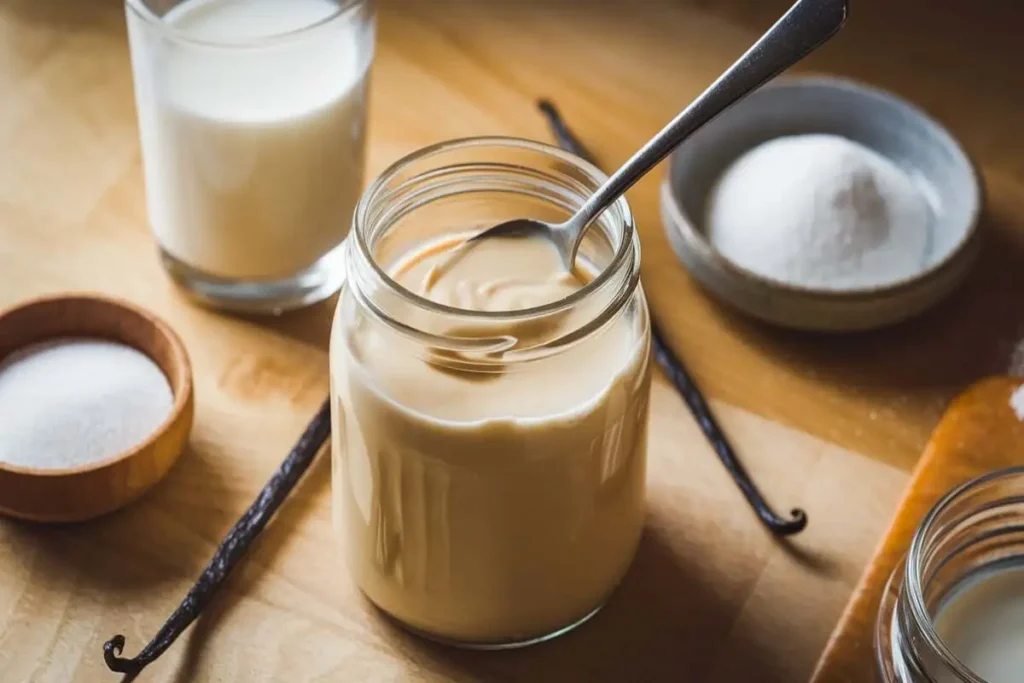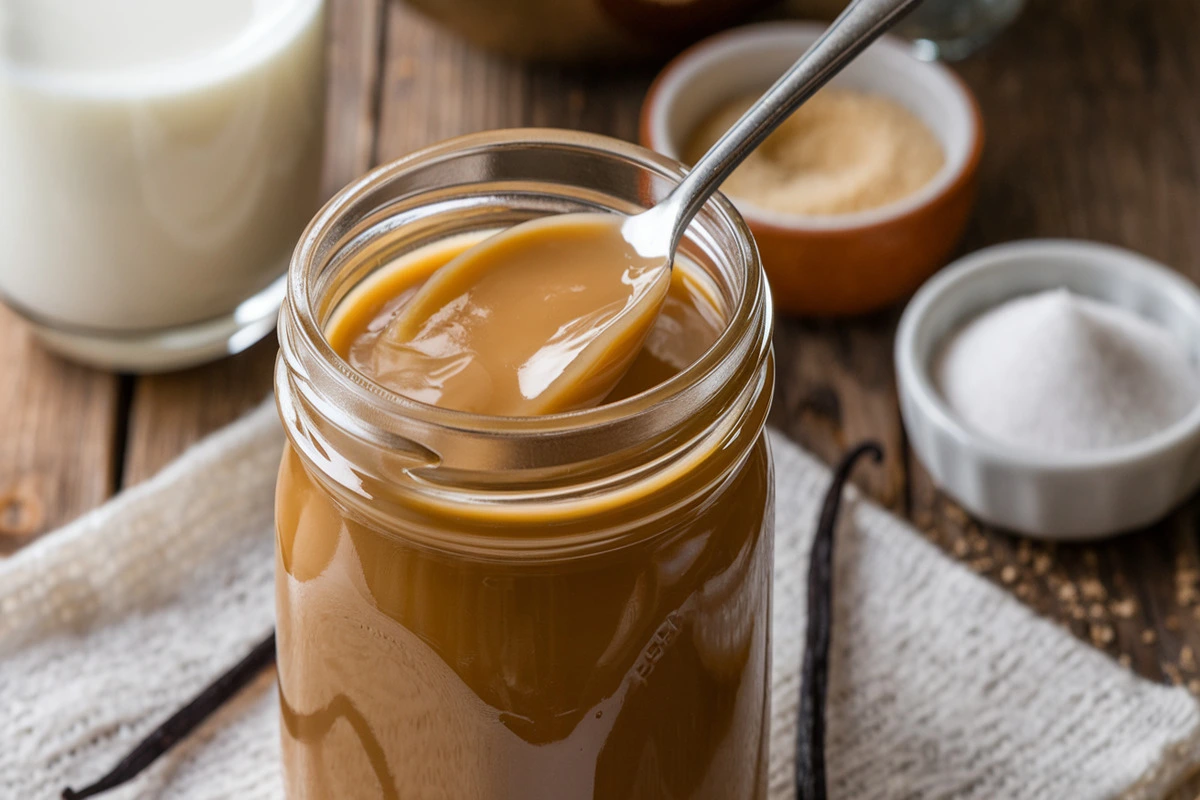Table of Contents: Condensed Milk Recipe
Introduction: Condensed Milk Recipe
There’s something magical about condensed milk—that thick, creamy, caramel-like sweetness that turns ordinary desserts into something extraordinary. Whether you’re drizzling it over pancakes, stirring it into coffee, or using it to make fudgy brownies, homemade condensed milk is a game-changer. And guess what? You don’t need a can! With just 3 simple steps and a handful of pantry staples, you can whip up your own rich, velvety condensed milk in no time.
Did you know that condensed milk was originally invented as a way to preserve milk before refrigeration? Today, it’s a baking essential—but store-bought versions often contain additives and excessive sugar. Making it at home gives you full control over the ingredients and sweetness. Plus, it’s cheaper and tastes even better!
If you loved our Homemade Dulce de Leche Recipe, you’ll adore this one—it’s just as easy but even more versatile. Ready to make the creamiest, dreamiest condensed milk? Let’s get started!
What is Condensed Milk?
Ever wondered why it’s called condensed milk? Well, the name says it all—it’s milk that’s been cooked down (condensed!) with sugar until thick and luscious. Think of it as milk’s sweeter, more indulgent cousin. Some say, “The way to a person’s heart is through their stomach,” and if that’s true, condensed milk is the ultimate shortcut!
Why buy it when you can make it fresher, creamier, and free of preservatives? Whether you’re baking a cake, making Thai iced tea, or just craving a spoonful straight from the jar, this Condensed Milk Recipe is your new best friend. Ready to see how easy it is? Let’s dive in!
Why You’ll Love This Condensed Milk Recipe

Creamy, dreamy perfection – No artificial thickeners, just pure, velvety sweetness that’s perfect for desserts, coffee, or even eating by the spoonful (we won’t judge!).
Saves money & avoids additives – Store-bought condensed milk can be pricey and packed with stabilizers. Making it at home costs pennies and tastes infinitely better.
Customizable sweetness – Prefer it less sugary? Adjust the sugar to your liking—something you can’t do with canned versions!
If you enjoyed our Homemade Evaporated Milk Recipe, you’ll love how simple this one is. Once you try it, you’ll never go back to store-bought! Ready to make your own? Let’s do this!
How to Make Condensed Milk
Quick Overview
✔ Prep Time: 2 minutes
✔ Cook Time: 45-60 minutes
✔ Total Time: Under 1 hour
✔ Difficulty: Super easy!
✔ Key Features: Only 2 ingredients, no fancy equipment, and thick, caramelized goodness!
Key Ingredients
- 4 cups whole milk (the richer, the better!)
- 1 cup granulated sugar (adjust to taste)
- 1 tsp vanilla extract (optional, for extra flavor)
Step-by-Step Instructions
Step 1: Simmer the Milk & Sugar
- In a heavy-bottomed saucepan, combine milk and sugar.
- Heat on medium-low, stirring constantly until sugar dissolves.
Step 2: Reduce & Thicken
- Once simmering, lower heat to low.
- Stir occasionally (scraping sides to prevent burning) for 45-60 minutes, until reduced by half and thick enough to coat the back of a spoon.
Step 3: Cool & Store
- Remove from heat, stir in vanilla (if using).
- Let cool—it will thicken further as it cools.
- Transfer to a jar and refrigerate for up to 2 weeks.
What to Serve With Condensed Milk
This versatile sweetener pairs perfectly with:
Coffee & Tea – Swap sugar for a spoonful of condensed milk in your morning brew.
Pancakes & Waffles – Drizzle generously for a decadent breakfast.
Ice Cream & Desserts – Use it in flans, tres leches cake, or as a dip for fruit.
Top Tips for Perfecting Condensed Milk
Low & Slow Wins – Rushing = burnt milk. Patience is key!
Use Full-Fat Milk – Skim milk won’t give the same richness.
Flavor Variations – Add cinnamon, cocoa powder, or coconut milk for a twist!
Storing & Reheating Tips
Fridge: Store in an airtight jar for up to 2 weeks.
Freezer: Pour into ice cube trays & freeze for 3 months (thaw before using).
Reheating: Warm gently in a saucepan with a splash of milk if too thick.
FAQs About Homemade Condensed Milk Recipe

1. Can I use low-fat milk instead of whole milk?
While you can use low-fat milk, whole milk works best because it yields a richer, creamier consistency. Skim milk may result in a thinner texture.
2. How long does homemade condensed milk last?
Stored in an airtight jar in the fridge, it keeps for up to 2 weeks. For longer storage, freeze it in ice cube trays (thaw before using).
3. Can I make dairy-free condensed milk?
Absolutely! Swap whole milk for coconut milk and adjust sugar to taste. The texture will be slightly different but still delicious.
4. Why is my condensed milk grainy?
This happens if the sugar isn’t fully dissolved. Stir constantly at the beginning and scrape the sides of the pan to prevent crystallization.
5. Can I use condensed milk as a substitute for evaporated milk?
No—they’re different! Evaporated milk is unsweetened, while condensed milk is thick and sugary. (Try our Homemade Evaporated Milk Recipe if you need that instead.)
6. Can I speed up the cooking process?
We don’t recommend it! High heat can scorch the milk, so low and slow is the way to go.
Conclusion: Why This Recipe is a Must-Try!
There you have it—the easiest, creamiest homemade Condensed Milk Recipe with just 2 ingredients and 3 simple steps! No more running to the store for canned versions filled with additives. This DIY version is:
✔ Cheaper – Save money with pantry staples.
✔ Customizable – Adjust sweetness and flavor to your liking.
✔ Versatile – Perfect for desserts, coffee, baking, and more!
Once you try it, you’ll wonder why you ever bought it pre-made. Whip up a batch today and take your sweets (and morning coffee!) to the next level.
Print
Homemade Condensed Milk
- Total Time: 50-65 minutes
- Yield: 1.5 cups (12 oz) 1x
- Diet: Vegetarian
Description
Creamy, sweet, and perfectly thick—this 3-ingredient Condensed Milk Recipe is easier than buying it canned! Perfect for coffee, desserts, and baking.
Ingredients
- 4 cups whole milk (or coconut milk for dairy-free)
- 1 cup granulated sugar (adjust to taste)
- 1 tsp vanilla extract (optional)
Instructions
- Simmer: In a heavy-bottomed saucepan, combine milk and sugar. Heat on medium-low, stirring until sugar dissolves.
- Reduce: Lower heat to low. Simmer for 45–60 minutes, stirring occasionally, until thickened (should coat the back of a spoon).
- Cool: Remove from heat, stir in vanilla (if using). Let cool—it thickens further as it cools. Store in a jar.
Notes
- Storage: Keeps in the fridge for 2 weeks or freeze for 3 months.
- Substitutions: Use coconut milk for dairy-free. Reduce sugar for a less sweet version.
- Pro Tip: Stir frequently to prevent burning!
- Prep Time: 2 minutes
- Cook Time: 45-60 minutes
- Category: Basics, Pantry Staples
- Method: Stovetop
- Cuisine: International
Nutrition
- Serving Size: 1 Tbsp
- Calories: 60
- Sugar: 10g
- Fat: 1.5g
- Saturated Fat: 1g
- Carbohydrates: 11g
- Protein: 1g
- Cholesterol: 5mg
Keywords: condensed milk recipe, homemade condensed milk, easy sweetened condensed milk

